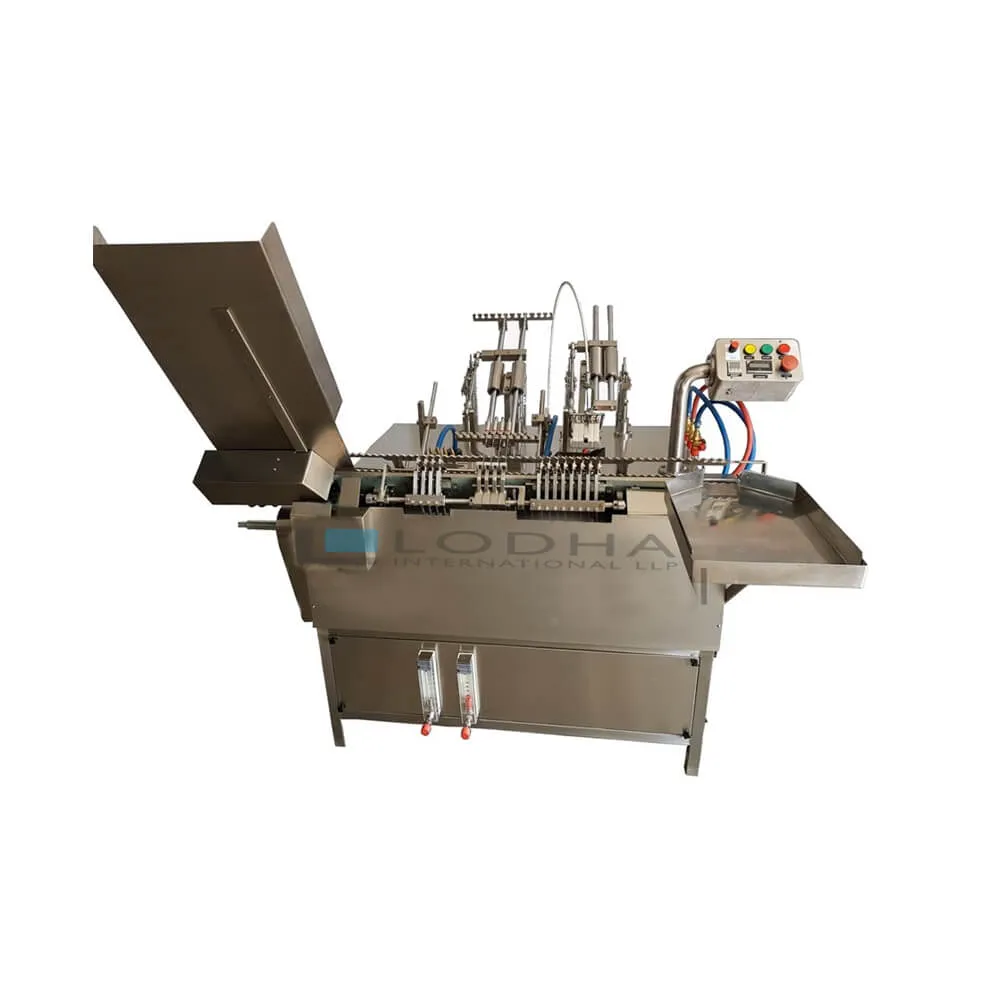Get in touch! +91 9687731331 | +91 9687631331 | info@lodhapharma.com
Automatic Ampoule Filling and Sealing Machine - Ampoule Filling Machine

History of Ampoule Filling and Sealing Machines
During the early years of the pharmaceutical industry, liquid products such as medicines were stored in small ampoules. Today, modern glass ampoules are used to store sterile solutions. These ampoules are made from short lengths of glass tubing.
During the mid-1890s, a French pharmacist named Stanislaus Limousin invented a new form of glass ampoulle. This new type was designed to safely store sterile solutions and liquids.
The modern-day ampoules are filled with a variety of specialized machines. These include machines that draw powders into the bottles, and those that seal the ampoules. The ampoules are then sterilized in autoclaves. They are then purged with nitrogen gas, which removes the atmospheric air from the bottles.
Many manufacturers of these types of machines are now launching models to increase production efficiency. These machines utilize several technologies, such as programmable logic controllers, to improve aseptic conditions. They also clean and label the bottles.
A typical filling machine includes a slant hopper and a pre-warming station. The slant hopper can hold up to eight ampoules at a time. The machine is then equipped with a sealing station, a combustible gas supply, and pressure reducers. It is covered with a stainless steel matt finish. The sealed ampoules are then automatically collected on a collection tray.
The liquid-filled ampoules are generally sealed using a tip-sealing method. This is the most common technique. It involves uniform heating of the neck of the ampoule. This causes the glass to soften and a bead to form.
Working Principle of Ampoule Filling and Sealing Machine
Whether you are looking for an ampoule filling and sealing machine or you are looking for a new one, it is important to understand the working principle of this type of equipment. Besides being effective, reliable, and efficient, these machines are also environmentally sensitive and can be used to fill liquids and powders.
Ampoule Filling and Sealing Machines are designed for processing and packaging of pharmaceutical, cosmetic, and biochemical products. This is an essential part of the pharmaceutical industry. They are designed to make it easy to store drugs, and prevent them from contaminating the environment. These machines are versatile and can be used in a wide variety of industries.
In the production process of an ampoule filling and sealing machine, first the ampoules are sterilized. This is done through an infeed conveyor that is located on the left side of the machine. These ampoules are then fed into a slant hopper.
An eccentric ampoule rack then sequentially performs the pre-heating and sealing operations. The rack also rotates the neck of the ampoules. This allows for a more centered position during the filling and sealing processes.
After the filling and sealing operations, the ampoules are then collected and placed on a collection tray in an upright position. Then the bottles are transported by a segment wheel to a conveyor cradle. The cradle carries eight ampoules in a group. The ampoules are then transferred to a conveyor belt that moves along a wire mesh.
Glass Ampoule Filling & Sealing Equipment
The operation of filling and sealing the glass ampoules is achieved with ampoule filling and sealing machine. It largely finds application in industries like cosmetic, chemical, pharmaceutical, veterinary, and biotech industries.
Ampoule Filler Machine Manufacturing
At Lodha Pharma, with our state of the art manufacturing facilities, we design and manufacture ampoule filling & sealing machine adhering to preset manufacturing standards to ensure of finest quality. The machines developed are standard as well custom made models tailored to meet the desired application. During the operation, principal of slant movement of ampoules is used in order to incorporate a wide array of ampoules that differ in ovality, thickness, and neck dimensions.
Ampoule Filling & Sealing Machine Quality Assurance
With the frame structure of the ampoule filler being made from stainless steel square pipes, it provides an assurity of durability and hence high productivity. The frames have a matt finished design and also include stainless steel coverings that impart them an aesthetic appearance. Maintaining and cleaning of the machine turns out to be quite an easy task as the bottom portion of the machine has a big opening area.
To make sure that the machine operation is secure all the time, a pendant type electric control panel is provided in the machine that is raised to ease out the process.
Salient Features of Ampoule Filling Machine & Sealing Machine
Ampoule Filling Machine Process
The operation of the machines starts with the sterilized ampoules being transferred to the hopper that is installed slantly. The transfer process of ampoules occur individually by the star wheel in an order manner on the ampoule rack that is eccentrically shaped having the capability of handling one/two/four/six ampoules.
Ampoule Sealing Machine Process
As the rack stops, pre-gassing, filling, post gassing, pre heating and sealing is performed in a sequential manner. These completely filled and sealed ampoules get transferred to the collection tray automatically without requiring any manual operation.
Ampoule Filler and Sealer Performs following operations
Advantages of Ampoule Filling Machine
Ampoule filler machine is extensively used by pharmaceutical companies for filling ampoules. It enables high production capacity to meet increasing demands. Companies can manufacture hundreds of ampules within short time with the help of ampoule filling machine. It is very easy to monitor ampoule filling process on ampule filling & sealing machine. Once the settings of ampule filler machine are completed, it can fill ampoules with the predefined amount of drugs. The biggest advantage of ampule filler machine is high accuracy. It ensure that exact amount of drug is filled in each ampule. As it is fully automatic, operating ampule filling and sealing machine is very easy.
Technical Specification of Ampoule Filling & Sealing Machine
| Model | LI-AFS 1 | LI-AFS 2 | LI-AFS 4 | LI-AFS 6 |
| No. of Head | Single | Two | Four | Six |
| Ampoule Handling Range | 1 ml to 20 ml | 1 ml to 20 ml | 1 ml to 10 ml | 1 ml to 10 ml |
| Production Output | 15 to 30 ampoules/minute | 30 to 55 ampoules/minute | 55 to 100 ampoules/minute | 80 to 150 ampoules/minute |
| Filling Accuracy | ± 1% | ± 1% | ± 1% | ± 1% |
| Require Gas for Sealing | LPG & Oxygen (O₂) | LPG & Oxygen (O₂) | LPG & Oxygen (O₂) | LPG & Oxygen (O₂) |
| Nitrogen Flushing | Pre & Post Nitrogen Flushing Available | Pre & Post Nitrogen Flushing Available | Pre & Post Nitrogen Flushing Available | Pre & Post Nitrogen Flushing Available |
| Power Specification | 0.5 H.P | 1 H.P. | 1 H.P. | 1 H.P. |
| Electrical Characteristics | 230 Volts, Single Phase, 50 Hertz, 4 Wire System | 230 Volts, Single Phase, 50 Hertz, 4 Wire System | 230 Volts, Single Phase, 50 Hertz, 4 Wire System | 230 Volts, Single Phase, 50 Hertz, 4 Wire System |
| Contact Parts | Made from Stainless Steel 316L | Made from Stainless Steel 316L | Made from Stainless Steel 316L | Made from Stainless Steel 316L |
| Non Contact Parts | Made from Stainless Steel 304 | Made from Stainless Steel 304 | Made from Stainless Steel 304 | Made from Stainless Steel 304 |
| Overall Dimension | 915mm (L) x 610mm (W) x 965mm (H) |
915mm (L) x 760mm (W) x 965mm (H) |
1200mm (L) x 1070mm (W) x 965mm (H) |
1600mm (L) x 1400mm (W) x 1400mm (H) |

